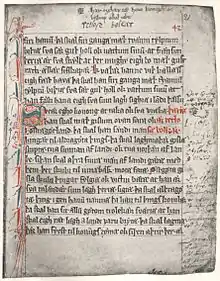Västgötalagen
Västgötalagen (Swedish pronunciation: [ˈvɛ̂ɧːœtaˌlɑːɡɛn] or [ˈvɛ̂sːtjøːta-]) or the Westrogothic law is the oldest Swedish text written in Latin script and the oldest of all Swedish provincial laws.[note 1] It was compiled in the early 13th century, probably at least partly at the instigation of Eskil Magnusson and was the code of law used in the provinces of Västergötland and Dalsland and in Mo härad during the latter half of that century. The earliest complete text is dated 1281. Small fragments of an older text have been dated 1250.[1]

This legal code exists in two versions, Äldre Västgötalagen and Yngre Västgötalagen (the Elder and Younger Westrogothic law, respectively). A first printing in modern times was published by Hans Samuel Collin and Carl Johan Schylter in 1827 (which made the text the subject of the earliest known stemma),[2] and a new edition by Gösta Holm in 1976.
The oldest manuscript of Äldre Västgötalagen contains other material added by a priest called Laurentius in Vedum around 1325. This material is of varying nature, including notes on the border between Sweden and Denmark and lists of bishops in Skara, lawspeakers in Västergötland and Swedish kings. The latter begins with Olof Skötkonung and ends with Johan Sverkersson.[3]
In these years, Swedish men left to enlist in the Byzantine Varangian Guard in such numbers that the medieval Swedish law, Västgötalagen, from Västergötland declared no one could inherit while staying in "Greece"—the then Scandinavian term for the Byzantine Empire—to stop the emigration,[4] especially as two other European courts simultaneously also recruited Scandinavians:[5] Kievan Rus' c. 980–1060 and London 1018–1066 (the Þingalið).[5]
See also
| Swedish Wikisource has original text related to this article: |
References
Notes
- The Scanian law is older, but Scania was not incorporated into Sweden until late 17th century, and it is thus counted as a Danish law.
Citations
- Cf. Inger Larsson, 'The Role of the Swedish Lawman in the Spread of Lay Literacy', in Along the Oral-Written Continuum: Types of Texts, Relations and the Implications, ed. by Slavica Ranković, Leidulf Melve, and Else Mundal, Utrecht Studies in Medieval Literacy, 20 (Turnhout: Brepols, 2010), pp. 411-27 (pp. 412-11).
- William Robins. 2007. Editing and evolution. Literature Compass 4: 89-120. (pp. 93-94). DOI: 10.1111/j.1741-4113.2006.00391.x.
- Original text (under item <15>). Based on the edition of Collin and Schlyter. Hosted by the University of Lund. See Beckman, Natanael (S1886): Medeltidslatin bland skaradjäknar 1943:1 s. 3.
- Jansson 1980:22
- Pritsak 1981:386
External links
- The Old Västergötland Law from the World Digital Library
- Äldre Västgötalagen from the Swedish Literature Bank
- Old Swedish and old Icelandic manuscripts from the National Library of Sweden
- Collin, H. S. and C. J. Schlyter (eds), Corpus iuris Sueo-Gotorum antiqui: Samling af Sweriges gamla lagar, på Kongl. Maj:ts. nådigste befallning, 13 vols (Stockholm: Haeggström, 1827--77), vol. 1 at